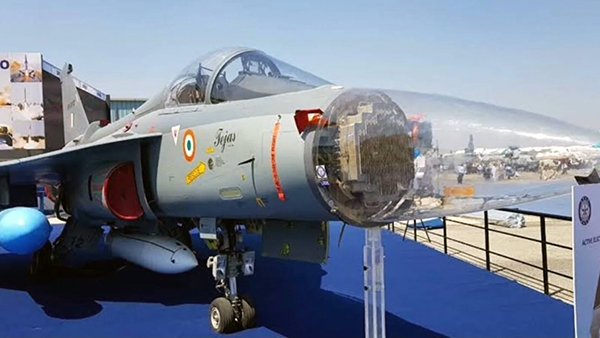India is making efforts to produce an array of indigenous technology and weapon systems so as to boost self-reliance in the defence sector. A major breakthrough has been achieved in the form of home-grown AESA radar, which is set to be integrated into the indigenous Tejas light combat aircraft (LCA).
The IAF is set to demonstrate the use of Active Electronically Scanned Array (AESA) radar developed in-house later this month, making India one of the few countries with an indigenous force multiplier that is used in electronic warfare, long-range missiles, and long-range precision-guided ammunition.
The 95% indigenous component in the radar system is in consonance with the government’s ‘Make in India’ initiative. Apart from India, “only the US, the EU, Israel, and China have AESA radar capability”, D Seshagiri, Head of the Electronics and Radar Development Establishment (LRDE) of the Defence Research and Development Organisation (DRDO), said, with only one imported subsystem. It can track 50 targets in the sky at a range of more than 100 kilometers and engage about four of them at the same time.
This also allows India to create a balance of power in the region with China which has been showcasing its stealth fighter J-20 as a means of achieving air superiority.
AESA employs an electronically controlled array antenna, which allows a beam of radio waves to be electronically guided in multiple directions without moving the antenna. It is primarily used in radar systems and allows the radar to have resistance to anti-jamming, low interception, multi-mode capability and high reliability because each of these modes functions independently.
Thus, India possessing the AESA Radar will protect its fighter aircraft that are already far short in number against the sanctioned strength, from enemy radars. This will achieve a dual purpose of early interception and attack. Given India’s geography and two-front war threats from China and Pakistan, it will function as a force multiplier for the IAF.
In the next five years, all 83 of IAF’s Tejas Mark I A fighters will have the The Uttam AESA Radar, as will the future twin-engine AMCA fighter developed by the Aeronautical Development Agency (ADA).
The first 16 Tejas MK 1A aircraft will be fitted with Israeli ELM 2052 AESA radars and the remaining will be fitted with the indigenous Uttam AESA radar, HT has learnt. “The radar has already been tested on two Tejas fighters as well as Hawker Siddeley 800 executive jet for over 250 hours. Only the US, the EU, Israel, and China have AESA radar capability,” Seshagiri said.
According to Seshagiri, the AESA radar will be installed on the radar cone of the Su-30 MKI aircraft as well as carrier-based MiG-29K fighters. “The LRDE has already signed an MoU with Hindustan Aeronautics Limited for Hindustan Aeronautics Limited to be the lead integrator of the radar on the Tejas Mk I A, with four recognized vendors, including BEL, as essential sub-system suppliers,” he said.
The first prototype of the radar was developed in 2012, and a full-scale model was shown during the 2017 Aero India aviation exhibition. At Aero India 2019, a fully functional AESA radar prototype was unveiled, placed inside the glass nose of a HAL Tejas fighter.
Earlier this year, Seshagiri had said, “On the LCAs, testing is currently focused on the air-to-air mode. The radar’s range should be about equal to that required to launch a BVR (beyond visual range) weapon. However, we’re getting a better range than that. We’re about to start a joint review after a few sorties. Following that, it will be ready for user testing.”
It is believed Astra Mark-2 air-to-air missile, developed by DRDO, is also equipped with an AESA active seeker, to improve the performance of the missile and replace the Russian radio frequency seeker used in the Astra Mk I, according to The New Indian Express. The air advantage China has achieved with its fifth-generation J-20 stealth fighters may be nullified by this radar, analysts believe.
The National Flight Testing Centre, which is manned by IAF, has already greenlighted the radar after successful performance tests. Earlier, India was using primary radars on its fighters as well as indigenous airborne warning and control systems planes. The Pakistani Air Force’s retaliation for the Balakot strike in February 2019 would have turned costly for Islamabad if Indian fighters had AESA radars mounted on intercepting fighters.
The AESA radar is also the key to the DRDO-developed Astra air-to-air missile, which has a range well over 120km, and will deliver guided ammunition over long distances. This radar will nullify the air superiority China had gained with its J20 multi-role fighters, as the Indian-developed AESA radar compares well with that developed by Beijing.


















